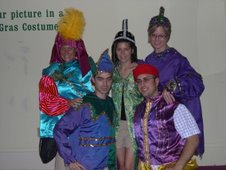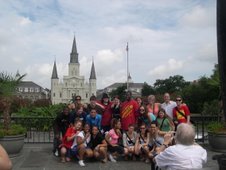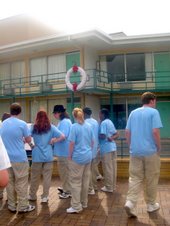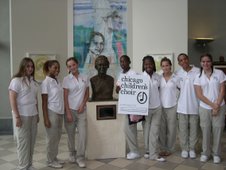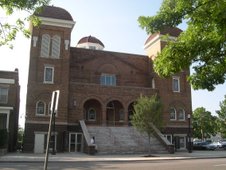Freedom Tour 2007
Sunday, August 5, 2007
Saturday, July 21, 2007
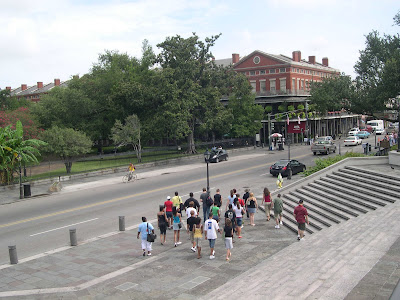
New Orleans looks good from the bus, and better on the streets in the French Quarter. You can say a prayer at the Cathedral or have your palm read, tarot cards cast, caricature sketched right outside in the plaza. Promises of beignets, po boy sandwiches, gumbo, jambalaya and chicory coffee come from cafés lining the narrow streets, overhung by balconies adorned by lacy ironwork.
A shadow lies behind it all--a consciousness that Katrina destroyed lives and homes and neighborhoods invisible from this pretty tourist part of town. The French Quarter and the business district and the more prosperous parts of the city have been/are being rebuilt, but the Black and poor sections of the Ninth Ward still suffer and struggle. Driving through Mississippi, I sensed the same shadow lurking just beyond the trees. Ther has been great progress, but segregation persists, as it does in Chicago, as it does in the Twin Cities. Schools are integrated in name, but segregated in fact because whites attend private schools or move out of the cities.
There's still work to be done, all over this land. On Saturday, the CCC members move from the cultural work of song to the carpentry work of Habitat for Humanity. They are a beacon of hope for the future.
Friday, July 20, 2007
Jasmine Henderson
So, my experience has been amazing. I couldn't have asked for more than what I've gotten. To know that I've somewhat been exposed to my own history in a text book is very important to me, but to see it with my own eyes makes everything come alive for me. My favorite part of this tour, yet, was the slave museum. I've never know anything to come more alive for me. It was amazing. I am truely grateful for everything that my elders have done for me to get me to the point of where I am.
From Julia
My experience with this tour so far has been so amazing. My favorite part is when we went to the slavery and civil rights museum, the Stax Records, and singing for Waveland. Oh yea, I finally got Motown down, yay. This tour has been good so far, but I hope to get better as it goes on.
Monday, July 16, 2007

Four museums, three performances, 200 miles -- the choir's stamina and energy are awesome! (And much greater than mine.) Today we shared the intensity of the Slavery Museum, the walking-in-great-footsteps across the Edmund Pettus bridge, the power of Rosa Parks and the movement she grew in and mothered at the same time. And the choir kept singing, and the audiences kept getting into their songs.
In Montgomery, as in Birmingham, the audience cannot stay just an audience. When the choir sings "We need you to survive" -- we believe it. You are singing to us. And we need you, too. The whole-souled singing of the choir, their flashing smiles, Phillip's hand to his heart, Josephine's intense energy dancing through her hands ... and then hands lift up out of the audience, fingers point to heaven, prayers get physical, and the spirit breaks free.
Yasmeen, of Sweet Honey in the Rock, writes of growing up singing "with a gospel growl and struttin' at the same time" so that the congregation was "standing and shoutin' every time." She goes on to say:
Singing is always giving and taking and giving and taking. The lyrics supply the focus. They determine how the song is sung each time it's sung and those same lyrics may have a different meaning from one day to the next. Each of us [in Sweet Honey in the Rock] knows our perspective on the topic and that perspective will reveal itself to the audience in five different ways... The listener has at least one of us she or he can relate to, which is powerful for me, and yes, we do talk to the audience while we sing, and yes, the requirement ... is that the audience responds during the singing, not only afterward. I told you--give-and-take.
From Birmingham to Selma to Montgomery, the songs and the singers keep giving and taking.
You Did It Again
I must echo Ed's comments on the Carnegie Hall performance. It was truly the best presentation of the choir I have seen on film, in print, or in pictures. I viewed it a few times and was awestruck by all of the singers (not just Kyra). I certainly hope someone can work on getting us copies for those of us who didn't capture it on DVD. Keep up the great work!
Tanya
Tanya
Sunday, July 15, 2007


On this Sunday, we visited the 16th Street Baptist Church, where Addie Mae Collins, 14. Denise McNair, 11; Carole Robertson, 14; and Cynthia Wesley were struck down by hatred and racism. On September 15, 1963, Ku Klux Klan bombers killed four young girls and wounded more than two dozen other people in a church on Sunday morning. Their deaths came just a few weeks after Dr. Martin Luther King, Jr. led the March on Washington and gave his famous "I have a dream" speech.
Today in the 16th Street Baptist Church, the choir sang "Birmingham Sunday."
On Birmingham Sunday a noise shook the ground.
And people all over the earth turned around.
For no one recalled a more cowardly sound.
And the choirs kept singing of Freedom.
I know we were standing on sacred ground. This is the very church where Denise and Addie and Carole and Cynthia prayed and sang and went to Sunday school. This is the very church where, on Monday night after Monday night, brave people gathered from 1958 onward to plan and work and organize to win freedom and justice and equal rights. Their heritage and their energy was with us as members of the congregation and guests and two choirs all linked arms and sang "We Shall Overcome" in the same church where Dr. Martin Luther King and Dr. Ralph Abernathy and Dr. Fred Shuttlesworth sang the same anthem.
Read more here.
Subscribe to:
Posts (Atom)
